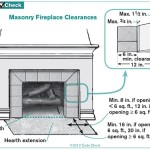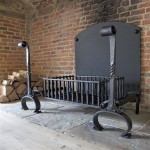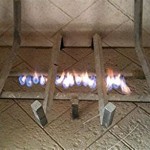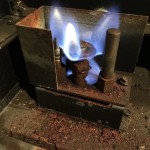Brass Fireplace Fenders: A Timeless Antique
Brass fireplace fenders, iconic fixtures in historic homes and cherished collectables, represent a fusion of functionality and artistry. These decorative barriers, traditionally crafted from brass, served a practical purpose of containing embers and preventing stray sparks from igniting carpets or flooring. Beyond their utilitarian value, they evolved into statements of elegance and refinement, frequently reflecting the prevailing aesthetic sensibilities of their respective eras. Antique brass fireplace fenders offer a tangible link to the past, embodying craftsmanship and design principles that continue to captivate collectors and homeowners alike.
The history of fireplace fenders is inextricably linked with the evolution of domestic heating and interior design. Initially, simple hearth guards made of wood or iron were employed to protect the surrounding environment from the dangers of open fireplaces. As architecture and interior decorating advanced, so too did the design and materials used for these protective barriers. Brass emerged as a particularly desirable material due to its durability, relative resistance to corrosion, and ability to be intricately worked and polished to a lustrous finish. The popularity of brass fireplace fenders reached its zenith during the Victorian and Edwardian periods, coinciding with a heightened emphasis on ornate detailing and opulent home furnishings.
The artistry and craftsmanship exhibited in antique brass fireplace fenders are hallmarks of their enduring appeal. Many fenders feature intricate piercing, repoussé work (a technique of hammering metal from the reverse side to create a raised design), and engraved details. Common motifs include floral patterns, geometric designs, classical figures, and heraldic emblems. The quality of the brass used and the skill demonstrated in its manipulation are key factors in determining the value and desirability of an antique fender. The presence of maker's marks or hallmarks further enhances the historical significance and provenance of a piece.
The designs of antique brass fireplace fenders vary considerably, reflecting the diverse styles prevalent during different historical periods. Georgian fenders, for example, often display a restrained elegance, characterized by clean lines and subtle ornamentation. Victorian fenders, in contrast, tend to be more elaborate, embodying the era's penchant for ornate detailing and lavish embellishments. Art Nouveau fenders, with their flowing, organic forms and stylized motifs, represent a distinct departure from earlier styles, embracing a more modern and artistic aesthetic. Edwardian fenders often exhibit a blend of these influences, incorporating elements of both Victorian grandeur and Art Nouveau simplicity.
Identifying and authenticating antique brass fireplace fenders requires a discerning eye and a familiarity with historical styles and manufacturing techniques. Key aspects to consider include the patina of the brass (the natural oxidation that occurs over time), the presence of original hardware and fixings, and the overall quality of the craftsmanship. A deep, even patina is generally indicative of age, although artificial patination can sometimes be applied to deceive potential buyers. Similarly, examining the joints and seams of the fender can reveal clues about its construction and age. The presence of casting flaws or imperfections may suggest a more recent reproduction, while hand-crafted details typically point to a genuine antique.
Key Aspects of Antique Brass Fireplace Fenders
To understand the value and appreciation for antique brass fireplace fenders, one must understand their multifaceted significance. This significance can be unpacked into three key aspects.
Aesthetic and Design Considerations
The aesthetic qualities of antique brass fireplace fenders are central to their appeal. The choice of design, the intricacy of the detailing, and the overall proportions of the fender all contribute to its visual impact. A well-designed fender can enhance the character of a fireplace and complement the surrounding décor. The patina of the brass, which develops over time, adds a layer of depth and character that is difficult to replicate in modern reproductions. Collectors often seek out fenders that display exceptional craftsmanship, rare designs, or unusual decorative elements.
Variations in design are often linked to the prevailing artistic trends of a particular era. For example, Arts and Crafts style fenders often exhibit a focus on handcrafted details and natural motifs, while Art Deco fenders are characterized by geometric patterns and streamlined forms. Understanding these stylistic nuances is essential for appreciating the aesthetic diversity of antique brass fireplace fenders.
The size and shape of the fender should also be considered in relation to the fireplace and the room in which it is placed. A fender that is too large or too small can look out of proportion and detract from the overall aesthetic. The shape of the fender should also complement the shape of the fireplace; for example, a curved fender may be more suitable for a rounded fireplace opening, while a straight fender may be better suited for a rectangular fireplace.
Historical and Societal Context
Antique brass fireplace fenders offer a tangible connection to the past, reflecting the social and cultural values of the eras in which they were produced. The materials used, the designs employed, and the level of craftsmanship displayed all provide insights into the lives and aspirations of people living in previous centuries. Owning an antique fender is like owning a piece of history, a reminder of a time when craftsmanship and attention to detail were highly valued.
The popularity of brass fireplace fenders coincided with a period of significant social and economic change. The rise of the middle class and the increasing availability of manufactured goods led to a greater emphasis on home decoration and comfort. Fireplace fenders, once a purely functional item, became increasingly decorative and elaborate, reflecting the growing affluence and sophistication of society.
The presence of maker's marks or hallmarks on an antique fender can provide valuable information about its origins and production. These marks can often be used to identify the manufacturer, the date of manufacture, and the location where the fender was made. This information can help to establish the provenance of the fender and to trace its history.
Functional and Practical Considerations
While antique brass fireplace fenders are primarily valued for their aesthetic and historical qualities, their original functional purpose should not be overlooked. A well-designed fender can provide a practical barrier against stray sparks and embers, helping to prevent accidents and protect carpets and flooring. The height and depth of the fender should be sufficient to contain any potential hazards, while the design should allow for easy access to the fireplace for tending the fire.
The construction of the fender is also an important consideration. A sturdy and well-made fender will be more durable and long-lasting. The joints and seams should be strong and secure, and the brass should be of a sufficient thickness to withstand the heat and wear of regular use.
When choosing an antique brass fireplace fender, it is important to consider the size and shape of the fireplace and the room in which it will be placed. The fender should be proportionate to the fireplace and should not obstruct the view of the fire. It should also be easy to clean and maintain. Regular polishing with a brass cleaner will help to keep the fender looking its best and to prevent the brass from tarnishing.
The preservation and care of antique brass fireplace fenders are essential for maintaining their value and historical significance. Regular cleaning with a soft cloth and mild brass cleaner will help to remove dust and dirt and prevent tarnishing. Avoid using abrasive cleaners or harsh chemicals, as these can damage the surface of the brass. If the fender is heavily tarnished, it may be necessary to consult a professional metal restorer. Proper storage in a dry and protected environment will also help to prevent corrosion and damage.
The market for antique brass fireplace fenders remains strong, with collectors and homeowners alike seeking out unique and historically significant pieces. The value of a fender depends on a variety of factors, including its age, design, craftsmanship, condition, and provenance. Rare and unusual fenders, especially those with maker's marks or historical significance, can command high prices at auction or in private sales. However, even relatively common fenders can be valuable if they are in good condition and possess desirable aesthetic qualities. The enduring appeal of these timeless antiques ensures their continued presence in homes and collections for generations to come.

Brass Fireplace Fender Wells Reclamation

Antique English George Iii Iv Period 19th Century Pierced Brass Fireplace Fender For At 1stdibs

Antique Brass Fireplace Fender With Circular Designs Paw Feet Circa 1900

Antique Fireplace Fender Brass France

Vintage Brass Fireplace Fender Fence Pot Rail Guard Surround Railing Antique Rack 2039

Antique Brass Fireplace Fenders Near Chicago Murco Recycling

Traditional Brass 5 Foot Antique Fireplace Fender Olde Good Things

Antique English Pierced Brass Fireplace Fender Chairish

Antique English Pierced Brass Fireplace Fender Chairish

141 Antique Fenders For Ingantiques Co
Related Posts








